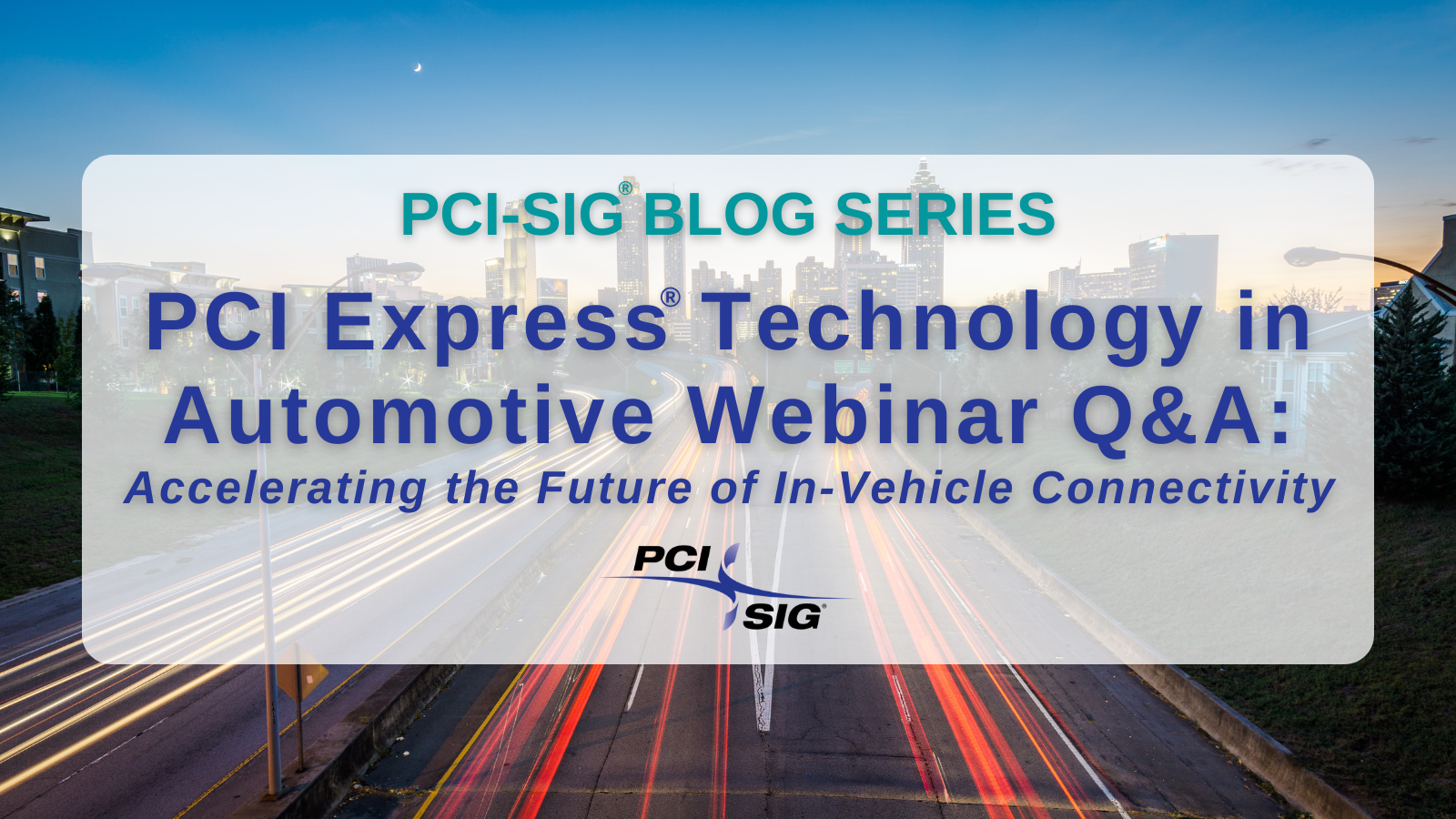PCI Express® Technology in Automotive Webinar Q&A: Accelerating the Future of In-Vehicle Connectivity

With the emergence of autonomous vehicles, AI-based advanced driver assistance systems (ADAS) and in-vehicle infotainment (IVI), today’s automobiles are becoming high-tech “servers on wheels.” PCI Express® (PCIe®) technology is expanding to become the interconnect of choice in automotive applications due to its high bandwidth, connectivity and robust technology ecosystem. In the recent PCI-SIG webinar, we provided an introduction to PCIe technology in automotive applications. This blog answers select questions from the audience that were asked during the webinar.
Introduction to PCIe Technology in Automotive Applications Webinar Questions
- Does PCI-SIG have any plans for reference clock redundancy for automotive?
In the PCIe specifications, it is possible for endpoint and root complex to have separate clocks. Clock forwarding is also possible, per current PCIe specifications. Specific PCIe Automotive considerations are under discussion in the AWG, and all members are invited to contribute.
- What about the long cable lengths necessary for connection from components to the Zone CPU to the central CPU? Would the PCIe signal lose fidelity?
Each PCIe link has a link loss budget depending on the data rate. Whether a long cable will exceed this loss budget depends on the cable length and the loss profile. It is possible that the cable length can exceed the allowed loss.
- In your Telematics Control Unit (TCU) use case example you showed the connection between the TCU and head unit. How long of a cable can (maximum length) can be used for such a use case?
The performance of a link is dependent on the channel characteristics and frequency. Different types of PHY technologies may reach different cable lengths depending on the type of cable.
- Will the use of Retimers along with PCIe technology be helpful in automotive applications in order to reduce latency and signal boost?
Yes, a Redriver or Retimer can be useful to extend the electrical reach by providing signal boost. However, it adds some amount of latency.
- Are there any requirements for low-power design in PCIe technology for automotive? What are the techniques used for low power in this case if any?
Low power solutions are important in automotive industry and PCIe technology is known for low power architecture. Specific PCIe Automotive considerations are under discussion in the AWG, and all members are invited to contribute.
- What kind of security features do you foresee for PCIe technology in automotive?
It is assumed that Authentication/Measurement (SPDM/CMA) will be mandatory, and link encryption should be application dependent, defined by each OEM/Tier-1, and based on the PCI-SIG IDE (Integrity & Data Encryption) specifications.
- Why would a zonal structure be the next-generation focus? There seems to be additional latency with minimal benefit versus centralized consolidation of all zonal sensors.
Zonal structure is a possible architecture option discussed by multiple OEM. The selection of an architecture based on its validity and benefits is done by each OEM per its own criteria.
- Because of the environment being a moving car, do you expect jitter requirements would be even tighter than a normal application?
We don’t anticipate there will be an impact on jitter requirements.
- Have you identified connectors specifically for automotive with sufficient resilience to vibration and fretting?
There are multiple Automotive solutions for connectors that can be evaluated as part of the AWG work, and all members are invited to contribute.
- Does PCI-SIG predict any specific physical layer compliance tests for PCIe technology in automotive for long-range apps, as the classic CEM interface doesn’t apply to automotive?
Our compliance tests, while focused on CEM, have in fact been successfully adopted for other form factors. We will also look at specific form factors that are relevant in the automotive space.
- What is the host type that is transmitting the data to the ADAS via PCIe technology?
PCIe technology is agnostic to the vendor, so any compliant root port, switch and endpoint can interoperate.
- Which generation of PCIe technology will be used in automotive first, based on your estimation?
PCIe technology is in fact used in automotive fairly widely today.
Learn more about PCIe technology in automotive
The recent PCI-SIG webinars, “An Introduction to PCIe Technology in Automotive Applications” and “PCIe Technology for Automotive Functional Safety” are available to view on demand on YouTube. Read the “Life in the Fast Lane: PCI Express Technology in Automotive” blog post to learn the reasons why PCIe technology is the interconnect of choice for today’s advanced vehicles. Subscribe to the PCI-SIG BrightTALK channel for future PCIe technology in automotive webinars.
